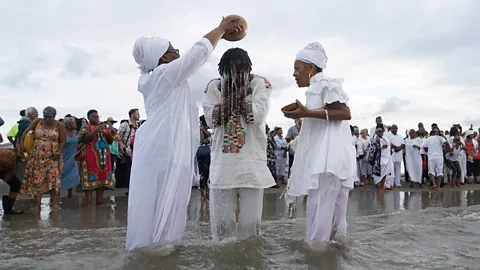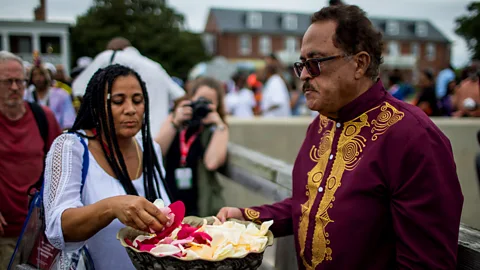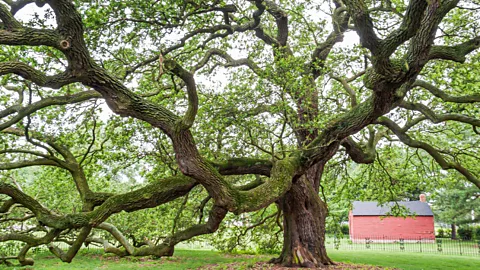Point Comfort: The little-known birthplace of African American culture
 Xinhua/Alamy
Xinhua/AlamyForty years after receiving an anonymous tip, one man has been working to rewrite Black history to show where and how the first Africans arrived in the British Colonies.
Standing in a gazebo at Fort Monroe National Monument, a former military base in Hampton, Virginia, Calvin Pearson, founder of the non-profit Project 1619 Inc, debunked a long-held belief that the first Africans who arrived in the British Colonies lacked the knowledge needed to survive in the Americas.
"They came here with the skills to produce iron, grow food, grow tobacco… they were already artisans," Pearson explained to a large crowd who had gathered to commemorate African Landing Day. The annual observance is held here at Fort Monroe each 23-25 August and honours the first Africans who landed in what would become the United States at this very spot in 1619. Today, Pearson and his non-profit, which has been working to change the narrative of how these first Africans arrived, refers to this place as "ground zero for Black American culture". But his journey to identify exactly where and how Black American culture began has been 40 years in the making.
In 1984, Pearson, who was the superintendent of Parks and Recreation for the City of Hampton, received an anonymous tip that led him on a 10-year search. The note claimed that the first Africans who landed in the 13 British Colonies didn't arrive in Jamestown, Virginia, the first permanent English settlement in the Americas, as had previously been thought, but 40 miles east at Fort Monroe – then called Point Comfort. Pearson later discovered a document written in 1619 by John Rolfe, the husband of Pocahontas and secretary for the colony of Virginia, stating: "About the latter end of August [1619], a Dutch [warship]… arrived at Point-Comfort… [carrying] not any thing but 20 and odd Negroes."
 Zach Gibson/Getty Images
Zach Gibson/Getty ImagesSo, why had historians maintained the first Africans arrived in Jamestown? According to Beth Austin, author of the 17-page report 1619: Virginia's First Africans, this Black American "ground zero" evolved into Jamestown simply because it was better known. "People had heard of Jamestown," Austin told the Virginia Mercury newspaper. "They hadn't heard of Point Comfort."
Further examination by Pearson of the Slave Voyages database and the work of historian Engel Sluiter proved that this "Dutch [warship]" was actually an English pirate ship named the White Lion waving a Dutch flag that had attacked a Portuguese galleon headed for Mexico. Portuguese privateers had been capturing Africans from the Kingdom of Ndongo in modern-day Angola since at least 1575 to work in silver mines in Mexico. Even more interesting, Pearson learned, is that since English pirates weren't involved in the transatlantic slave trade in 1619, once these captured Angolans stepped aboard the White Lion, they were no longer in bondage.
"When they were captured by the White Lion, there were no more chains and they were allowed to roam the ship," Pearson emphasised. "[These pirates] had no interest in capturing Africans – they were looking for gold and silver."
In 1996, Pearson presented his findings to the Virginia Department of Historic Resources, and in 2015, historical signs at Jamestown and Fort Monroe were edited to reflect that Point Comfort was the original landing place of the first Africans in the British Colonies.
"In Virginia, we were taught a false narrative about our ancestors," Pearson said. "In school, we were required to take field trips to Jamestown and were told this is where your ancestors landed."
 Xinhua/Alamy
Xinhua/AlamyToday, many American students still tour the Historic Triangle that consists of Jamestown, Colonial Williamsburg and Yorktown, but few make it to Fort Monroe. According to Dr Cassandra Newby-Alexander, endowed professor of Virginia Black History and Culture at nearby Norfolk State University, students learning about Virginia's Black history often complain about hearing "slave stories".
"What they're tired of hearing is lies," she said. "The version of history we're told robs the Angolans [in Virginia] of their agency, and what I want people to know is that their ancestors had agency." As a result, she trains public school teachers about the little-known history of Point Comfort.
Pearson says because slavery wasn't legalised in Virginia until 1661, the first Angolans who arrived on the White Lion were categorised as "servants". And while they were promptly sold to Virginia's governor and trade officer and undoubtedly subjugated, their servitude was decidedly different than the chattel slavery most Americans think of today.
According to the 1619: Virginia's First Africans report, many of the "20 and odd" Black people who arrived in 1619 ended up "living in the households" of white colonists and later being freed. The Encyclopedia Virginia notes that "until the latter part of the 17th Century, [Virginia's free Black people] enjoyed many of the same rights as free whites," and free Black people were able to earn money, buy land, vote and argue for their rights in court.
 Tomka/Alamy
Tomka/AlamyThe Slave Voyages database shows 824 more Africans arrived in British North America between 1626-1675. But according to Newby-Alexander, in the decades after the 1619 landing, more and more laws were passed in Virginia that were designed to erode Black people's freedoms. Then in 1661, tempted by the prospect of free labour to fuel its agricultural expansion, Virginia passed a law stating any free person could own slaves. A year later, the Virginia General Assembly passed another law declaring that all children born to an enslaved mother would themselves be enslaved – effectively sowing the seeds of a form of slavery based almost entirely on race and extinguishing the brief legacy of Black empowerment and freedom that was born at Point Comfort.
Yet, this wouldn't be the end of Point Comfort's story. In fact, the reason that Pearson refers to this little-known site on the Chesapeake as "the birthplace of Black American culture" is that, in addition to being the first place where Black people could gain their freedom in the British Colonies, it also played another pivotal role in African American history.
Exactly 200 years after Virginia legalised slavery, three enslaved Black men escaped from their "owners" in the midst of the US Civil War in 1861 and arrived at the site (now a military base called Fort Monroe), which was held by the Union army. Union General Benjamin Butler refused to return the men, declaring them "contraband" of war. Within a month, some 900 African American freedom-seekers had fled to Fort Comfort, transforming the military stronghold into a refuge of emancipation. To accommodate the influx, Union officials established the "Great Contraband Camp" in the war-torn remains of the surrounding city of Hampton. Today, this makeshift camp is considered the first self-contained Black community in the US, and it grew to a population of several thousand by 1865.
Today, travellers can learn about both the First Landing and the Great Contraband Camp as they tour the National Monument, as well as the Visitor & Education Center at Fort Monroe (nicknamed "Freedom's Fortress"). Nearby, visitors can look up at the sprawling branches of the oak tree where Mary Smith Peake, the first Black teacher hired by the American Missionary Association taught the freedom-seeking "contrabands" how to read. In 1863, this same oak would be the site of the first Southern reading of the Emancipation Proclamation that led to the abolition of slavery in the US. Five years later, the historically Black Hampton University was founded at the site of the tree, and today, the graceful Emancipation Oak still stands at the university's entrance.
 Jeffrey Isaac Greenberg 9+/Alamy
Jeffrey Isaac Greenberg 9+/Alamy"The significance of this property is not just Black history; it's American history," said Glen Oder, executive director of the Fort Monroe Authority. Oder hopes that the fort and surrounding beach where Africans first arrived in the British Colonies will become a pilgrimage site for every American. To attract more visitors, the Fort Monroe Authority is currently planning a new African Landing Memorial (scheduled for completion in 2026), which will be part of a larger African Landing Park overlooking the Chesapeake Bay.
But for now, it's the sound of the djembe drum during the annual African Landing Day festivities that lures descendants of the enslaved back to where they first landed. Just before dawn on the second day of the event, more than 100 Black people gathered at Outlook Beach near Fort Monroe to participate in an African cleansing ceremony designed to help connect Black Americans to their ancestors.
According to Robin "Osunnike Anke" Scott-Manna, the co-founder of The Institute of Whole Life Healing who led the ceremony, the ritual often triggers an intense response in participants. As more individuals took part in the ritual, the beat of the djembe drum intensified, and some people burst into tears.
According to Scott-Manna, this "letting go" is a release of anger and pain carried for so many years.
"We have to know the truth of who we are, why we are and to rewrite our lives moving forward," Scott-Manna said. "It's time for all the pain, suffering and trauma to be transmuted… this is not our original history."
Rediscovering America is a BBC Travel series that tells the inspiring stories of forgotten, overlooked or misunderstood aspects of the US, flipping the script on familiar history, cultures and communities.
---
If you liked this story, sign up for the weekly bbc.com features newsletter called "The Essential List". A handpicked selection of stories from BBC Future, Culture, Worklife and Travel, delivered to your inbox every Friday.
